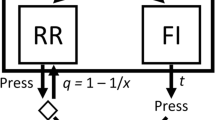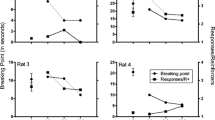Abstract
Acute treatment with antidepressant drugs is known to increase the mean interresponse time (IRT) in the IRT >72-s schedule of reinforcement. In order to examine the possibility that this effect may reflect an action of the antidepressants on timing processes, we tested the effects of two antidepressants, desipramine and fluvoxamine, on behaviour maintained under two other timing schedules in rats. In the fixed-interval peak procedure (fixed-interval 30-s), acute treatment with desipramine (8 mg kg−1) reduced response rate, whereas acute treatment with fluvoxamine (8 mg kg−1) increased it. Neither drug significantly altered the time to attainment of peak response rate or the Weber fraction. In the interval bisection task (standard durations 2 s and 8 s), the bisection point was not significantly altered by acute treatment with either drug. Chronic treatment with desipramine (8 mg kg−1 b.d.) had no effect on any of the indices of timing under either schedule. Chronic treatment with fluvoxamine (8 mg kg−1 b.d.) reduced the time to attainment of peak response rate but had no effect on the Weber fraction under the fixed-interval peak procedure, and did not alter the bisection point or Weber fraction under the interval bisection procedure. The failure of desipramine and fluvoxamine to increase the time to peak response rate or the bisection point at doses that significantly altered operant response rate suggests that the effect of these drugs on IRT schedule performance is unlikely to reflect an interaction with timing processes.
Similar content being viewed by others
References
Benfield P, Ward A (1986) Fluvoxamine: a review of its pharmacodynamic and pharmacokinetic properties, and therapeutic efficacy in depressive illness. Drugs 32:313–334
Catania AC (1970) Reinforcement schedules and psychophysical judgements: a study of some temporal properties of behavior. In: Schoenfeld WN (ed) The theory of reinforcement schedules. Appleton-Century-Crofts, New York
Church RM, Deluty MZ (1977) Bisection of temporal intervals. J Exp Psychol [Anim Behav Proc] 3:216–228
Church RM, Meck WH (1988) Biological basis of the remembered time of reinforcement. In: Commons ML, Church RM, Stellar JR, Wagner AR (eds) Quantitative analysis of behavior: 7, Biological determinants of reinforcement. Erlbaum, Hillsdale, N.J., pp 103–119
Church RM, Miller KD, Meck WH, Gibbon J (1991) Symmetrical and asymmetrical sources of variance in temporal generalization. Anim Learn Motiv 19:207–214
Fetterman JG, Killeen PR (1992) Time discrimination inColumba livia andHomo sapiens. J Exp Psychol [Anim Behav Proc] 18:80–94
Fletcher PJ (1993) A comparison of the effects of dorsal or median raphe injections of 8-OH-DPAT in three operant tasks measuring response inhibition. Behav Brain Res 54:187–197
Fundaro A, Cassone MC, Molinengo L (1983) Action of antidepressants, stimulants and depressants in the transition from a fixed ratio to a fixed interval schedule of reinforcement. Prog Neuropsychopharmacol Biol Psychiatry 7:57–62
Gibbon JJ (1991) Origins of scalar timing. Learn Motiv 22:3–38
Graham S, Ho M-Y, Bradshaw CM, Szabadi E (1994) Facilitated acquisition of a temporal discrimination following destruction of the ascending 5-hydroxytryptaminergic pathways. Psychopharmacology 116:373–378
Gundersen JH, Berntzen D (1983) Rate dependent effects of imipramine. Scand J Psychol 24:237–242
Ho MY, Al-Zahrani SSA, Velazquez Martinez DN, Lopez Cabrera M, Bradshaw CM, Szabadi E (1995) The role of the ascending 5-hydroxytryptaminergic pathways in timing behaviour: further observations with the interval bisection task. Psychopharmacology 120:213–219
Killeen PR, Fetterman JG (1988) A behavioral theory of timing. Psychol Rev 95:274–295
Kornetsky C (1965) A comparison of the effects of desipramine and imipramine on two schedules of reinforcement. Int J Neuropharmacol 4:13–16
Lewis D (1960) quantitative methods in psychology. Springer, Berlin Heidelberg New York
Loullis CC, Wayner MJ (1979) Effects of imipramine on schedule dependent and schedule induced behavior. Pharmacol Biochem Behav 11:725–728
Marek GJ, Seiden LS (1988) Selective inhibition of MAO-A, not MAO-B, results in antidepressant-like effects on DRL 72-s behavior. Psychopharmacology 96:153–160
Marek GJ, Li AA, Seiden LS (1989a) Selective 5-hydroxytryptamine2 antagonists have antidepressant-like effects on differential-reinforcement-of-low-rate 72-second schedule. J Pharmacol Exp Ther 250:52–59
Marek GJ, Li AA, Seiden LS (1989b) Evidence for involvement of 5-hydroxytryptamine1 receptors in antidepressant-like drug effects on differential-reinforcement-of-low-rate 72-second scedule. J Pharmacol Exp Ther 250:60–71
Maricq AV, Church RM (1983) The differential effects of haloperidol and methamphetamine on time estimation in the rat. Psychopharmacology 79:10–15
Maricq AV, Roberts S, Church RM (1981) Methamphetamine and time estimation. J Exp Psychol [Anim Behav Proc] 7:18–30
McGuire PS, Seiden LS (1980) Differential effects of imipramine in rats as a function of DRL schedule value. Pharmacol Biochem Behav 13:691–694
McKearney JW (1968) The relative effects ofd-amphetamine, imipramine and harmaline on tetrabenazine suppression of schedule-controlled behavior in the rat. J Pharmacol Exp Ther 159:429–440
Molinengo L, Ricci-Gamalero S (1972) The action of imipramine, amitriptyline, doxepin and butriptyline in an operant conditioning schedule. Psychopharmacologia 24:247–258
Morrissey G, Wogar MA, Bradshaw CM, Szabadi E (1993) Effect of lesions of the ascending 5-hydroxytryptaminergic pathways on timing behaviour investigated with an interval bisection task. Psychopharmacology 112:80–85
Morrissey G, Ho M-Y, Wogar MA, Bradshaw CM, Szabadi E (1994) Effect of lesions of the ascending 5-hydroxytryptaminergic pathways on timing behaviour investigated with the fixed-interval peak procedure. Psychopharmacology 114:463–468
O'Donnell JM, Seiden LS (1982) Effects of monoamine oxidase inhibitors on performance during differential reinforcement of low response rate. Psychopharmacology 78:214–218
O'Donnell JM, Seiden LS (1983) Differential-reinforcement-of-low-rate 72-second schedule: selective effects of antidepressant drugs. J Pharmacol Exp Ther 224:80–88
Platt JR (1984) Motivation and response factors in temporal differentiation. In: Gibbon J, Allan L (eds) Timing and time perception. Ann NY Acad Sci 423:200–210
Pollard GT, Howard JL (1986) Similar effects of antidepressant and non-antidepressant drugs on behavior under an interresponse time >72s schedule. Psychopharmacology 89:253–258
Rastogi SK, MacMillan DE (1985) Effects of some typical and atypical antidepressants on schedule-controlled responding in rats. Drug Dev Res 5:243–250
Richards JB, Seiden LS (1991) A quantitative interresponse-time analysis of DRL performance differentiates similar effects of the antidepressant desipramine and the novel anxiolytic gepirone. J Exp Anal Behav 56:173–192
Richards JB, Sabol KE, Seiden LS (1993) Fluoxetine prevents the disruptive effects of fenfluramine on differential-reinforcement-of-low-rate 72 second schedule performance. J Pharmacol Exp Ther 267:1256–1263
Roberts S (1981) Isolation of an internal clock. J Exp Psychol [Anim Behav Proc] 7:242–268
Seiden LS, Dahms JL, Shaughnessy RA (1985) Behavioral screen for antidepressants: the effects of drugs and electroconvulsive shock on performance under a differential-reinforcement-of-low-rate schedule. Psychopharmacology 86:55–60
Shah K, Bradshaw CM, Szabadi E (1990) Interaction between antidepressants andd-amphetamine on variable-interval performance. Psychopharmacology 100:548–554
Szabadi E, Bradshaw CM (1995) Affective disorders: 1. Antidepressants. In King DJ (ed) Seminars in clinical psychopharmacology. Gaskell, London
Tucker JC, File SE (1986) The effect of tricyclic and “atypical” antidepressants on spontaneous locomotor activity in rodents. Neurosci Behav Rev 10:115–121
Zeiler MD (1977) Schedules of reinforcement, the controlling variables. In: Honig WK, Staddon JER (eds) Handbook of operant behavior. Prentice Hall, Englewood Cliffs, N.J.
Author information
Authors and Affiliations
Rights and permissions
About this article
Cite this article
Ho, M.Y., Al-Zahrani, S.S.A., Velazquez Martinez, D.N. et al. Effects of desipramine and fluvoxamine on timing behaviour investigated with the fixed-interval peak procedure and the interval bisection task. Psychopharmacology 125, 274–284 (1996). https://doi.org/10.1007/BF02247339
Received:
Revised:
Issue Date:
DOI: https://doi.org/10.1007/BF02247339




